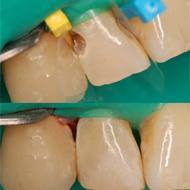CONSERVATIVE/ RESTORATIVE DENTISTRY
Direct restorations made of composite material
The direct restoration is performed by the dentist on the patient in just one chair-section (filling). Among the advantages of composite materials compared to metallic materials (amalgam) there are the aesthetics, a lower cavity preparation with the advantage of preserving more healthy tissue and the possibility of strengthening the remaining tooth structure. The chemical and physical properties of the latest generation of composite materials that are reliable over time make the aesthetic restorations stable even in the posterior areas. They are in fact highly resistant to masticatory forces, radiopaque, with elastic properties similar to dentin, and a wear resistance comparable to enamel and amalgam.
Indirect restorations made of composite material
This is the same material described above, but with a different execution procedure. When the surface of the tooth to be reconstructed is very large, or you have to improve the shape and the colour (e.g. incisors) “inlays” or “facets” are used made with INDIRECT TECHNIQUE because they are not made directly by the dentist, but by the dental technician: using a plaster model made from an impression of the dental arches and based on the cast, the composite restoration is prepared and sent to the dentist, who shall place it in the patient’s mouth and secure with special cements.
Indirect restorations in gold
Gold has biocompatibility and precision characteristics that make it unsurpassed compared to other metals. The inlays in gold are preferred when, in the presence of a very large cavity, the amount of enamel residue is not sufficient to ensure good adhesion and good resistance to masticatory loads, necessary for restorations with composite material. The ductility of gold ensures a perfect marginal seal and a long-term outcome superior to any other type of prosthetic restoration. However the aesthetic appearance is certainly a disadvantage, thus this solution can be considered if the restoration is not highly visible.
Pre-prosthetic reconstruction of endodontically treated elements
A tooth subject to an important carious process may require an endodontic treatment in order to position an endodontic pin that allows a greater retention and resistance of the coronal restoration. The endodontic pins used today in dentistry can be constructed with different materials depending on the properties that they present (molten alloy or composite fibres).
Inlays
These are indirect restorations that are made in laboratories from different materials (composite, gold and ceramics). When the surface of the tooth to rebuild is very large, the “inlays” used are made with the INDIRECT TECHNIQUE.
Bonding and conservative aesthetics
The micromechanical coupling of the restorative material to the dentin is performed with a layer of adhesive, and is defined as adhesion to dentin. During the steps of applying primer and adhesive, the resin penetrates into the collapsed collagen fibres of the enamel (after demineralization) and creates a network structure. This procedure allows the composite resin to bind to the dentin surface with a very durable and long lasting chemical bond, allowing to reconstruct the portion of the carious tooth with direct and indirect restorations. It can be used to close dental spaces (diastema), fill small cavities, eliminate stains, repair chipped enamel or small fractures of the anterior teeth.
Alignment of the teeth with the adhesive technique
Today it is possible to correct small misalignments of the front teeth, without necessarily having to undergo orthodontic treatment. This is obtainable by coating the front surface of our teeth with veneers.
Three procedures are available:
Direct: correction with composite.
Direct with preformed veneers (sold commercially) placed in the practice.
Indirect veneers made in the laboratory (usually ceramic).

